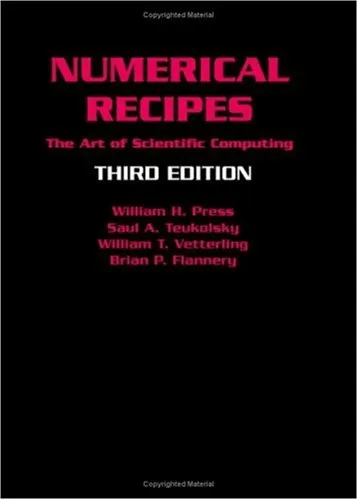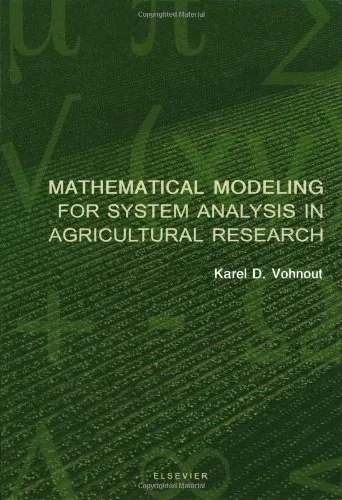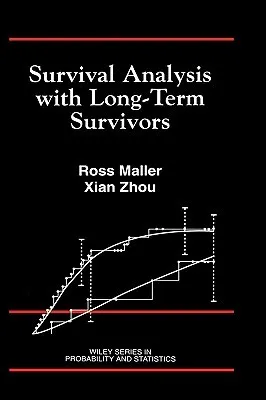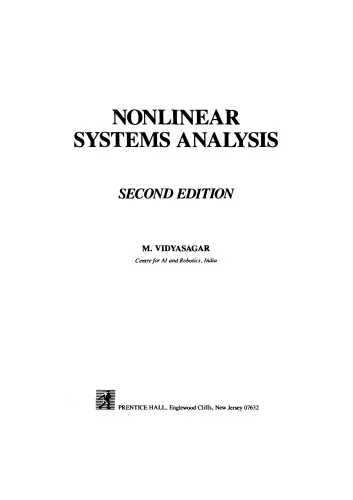Complexity
3.7
بر اساس نظر کاربران

شما میتونید سوالاتتون در باره کتاب رو از هوش مصنوعیش بعد از ورود بپرسید
هر دانلود یا پرسش از هوش مصنوعی 2 امتیاز لازم دارد، برای بدست آوردن امتیاز رایگان، به صفحه ی راهنمای امتیازات سر بزنید و یک سری کار ارزشمند انجام بدینکتاب های مرتبط:
خلاصه تحلیلی کتاب
کتاب Complexitypp.22—27 بخشی خاص از یک اثر گسترده درباره نظریه پیچیدگی است که به بررسی دقیق رفتار سیستمهای پیچیده، ویژگیهای emergent، و تعامل میان عناصر در سطوح مختلف میپردازد. این بخش از کتاب، برهمکنش میان نظم و بینظمی، روندهای خودسازماندهی، و نقش criticality در تحول سیستمها را با دقت علمی و با ارجاع به مثالهای چندرشتهای تحلیل میکند.
در این صفحات، نویسنده با تلفیق دیدگاههای فیزیک، زیستشناسی، و علوم رایانه، تصویری چندگانه از مفهوم complexity ارائه میدهد. بخش قابلتوجهی از تحلیل بر روی تفاوت میان ساختارهای ایستا و سیستمهای پویا متمرکز است، جایی که روابط غیرخطی و بازخوردها عامل تغییرات غیرقابل پیشبینی میشوند. خواننده با مطالعه این فصلها، با بنیانهای علمی نظریه پیچیدگی و ارتباط آن با محیطهای واقعی، همچون شبکههای اجتماعی، اکوسیستمها، و معماریهای محاسباتی آشنا میگردد.
نکات کلیدی و کاربردی
یکی از نکات کلیدی این بخش، فهم عمیق مفهوم self-organization یا خودسازماندهی است. این فرایند که در بسیاری از سیستمها مشاهده میشود، بدون نیاز به کنترل خارجی، ساختارها و الگوهای منظم ایجاد میکند. در صفحات ۲۲ تا ۲۷، مثالهای روشنی از پدیدههایی که این رفتار را نمایش میدهند آورده شده است.
نکته دیگر، اهمیت adaptive systems یا سیستمهای تطبیقی است که قادرند خود را با شرایط محیطی تازه هماهنگ کنند. نویسنده نشان میدهد که این قابلیت، نهتنها در موجودات زنده بلکه در ساختارهای مصنوعی مانند الگوریتمهای یادگیری ماشین نیز دیده میشود.
نکته کاربردی سوم، تبیین ارتباط بین chaos theory و نظریه پیچیدگی است؛ بیان اینکه آشوب الزاماً به معنای بینظمی نیست بلکه میتواند منبعی برای ظهور نظم جدید باشد.
نقلقولهای ماندگار
برخی از جملات این فصلها بهسبب ایجاز و عمق مفهومی، تبدیل به نقلقولهایی ماندگار در حوزه مطالعه complexity شدهاند.
«در قلب هر سیستم پیچیده، تعادلی ظریف میان نظم و آشوب وجود دارد که حیات آن را حفظ میکند.» نامشخص
«نظم خودسازمانیافته، نه از دستورات مرکزی، بلکه از کنشهای ساده و پیوسته اجزاء ناشی میشود.» نامشخص
چرا این کتاب اهمیت دارد
اهمیت Complexitypp.22—27 در این است که بخش کوچکی از کتاب، با تمرکز بر بنیانهای نظری و مصادیق عملی، پلی میان علوم مختلف ایجاد میکند. این رویکرد بینرشتهای به پژوهشگران کمک میکند تا مفاهیم پیچیدگی را نه بهصورت انتزاعی، بلکه در بسترهایی ملموس و قابلمشاهده درک کنند.
با توجه به اینکه بسیاری از مسائل عصر حاضر – از تغییرات اقلیمی گرفته تا ساختارهای اطلاعاتی – در قالب سیستمهای پیچیده قابل تحلیل هستند، این کتاب منبع ارزشمندی برای توسعه چارچوبهای فکری در مواجهه با چالشهای کلان محسوب میشود. اطلاعات دقیق درباره سال انتشار یا جوایز دریافتشده این بخش، متأسفانه «اطلاعات نامشخص» است، زیرا منبع معتبر در دسترس نیست.
نتیجهگیری الهامبخش
مطالعه Complexitypp.22—27 فرصتی منحصر بهفرد برای درک عمیقتر ماهیت پیچیدگی و نقش آن در جهان امروز فراهم میآورد. این بخش نهفقط یک مرور نظری، بلکه دعوتی به نگاه تازه به پیرامون است. از پژوهشگر تا علاقهمند به فلسفه علم، هر کسی میتواند از این صفحات الهام بگیرد.
پیام نهایی این است که پیچیدگی را باید پذیرفت، کاوش کرد و به کار گرفت. اگر به دنبال توسعه
Analytical Summary
Complexitypp.22—27 is a concentrated examination of the intellectual threads that run through the science of complexity, where mathematics, physics, biology, and social sciences intersect. The section captures a pivotal range of pages that articulate the nuanced ways systems adapt, self-organize, and display emergent properties.
As part of the larger work by Douglas S. Robertson, these pages offer a microcosm of the book’s broader intent: illuminating the hidden architectures that govern how disparate elements aggregate into coherent wholes. The discussion unfolds with the precision of academic analysis coupled with the accessibility necessary to engage serious readers beyond a narrow academic circle.
With clarity and rigor, Complexitypp.22—27 examines examples drawn from nature, technology, and human organizations, aiming to show how common principles of complexity manifest across contexts. Throughout, the prose balances technical insight with conceptual breadth, making it an essential reference point for professionals and researchers seeking to deepen their understanding of complex systems analysis.
Key Takeaways
From this segment of the book, readers will glean conceptual tools and frameworks that sharpen their ability to identify, interpret, and work with complex phenomena.
First, complexity is shown to be more than a metaphor; it is a formal study of how interacting parts create behavior that cannot be fully predicted from the properties of the parts themselves.
Second, the narrative emphasizes the interdisciplinary nature of complexity science, tying together threads from mathematics, biology, and the social sciences to build a unified perspective.
Third, detailed examples demonstrate how feedback loops, nonlinearity, and adaptive capacity distinguish complex systems from merely complicated ones.
Finally, readers are encouraged to think critically about the limits of prediction and control when dealing with adaptive systems, a theme that resonates across research and professional practice.
Memorable Quotes
"In complexity, the whole reveals properties absent from its parts." Unknown
"Systems learn, adapt, and transform in ways that challenge linear logic." Unknown
"Interdisciplinarity is not optional in the study of complexity; it is inherent." Unknown
Why This Book Matters
Complexitypp.22—27 stands out because it encapsulates both the theoretical sophistication and practical relevance of complexity science within a concise range of pages.
Professionals in fields as diverse as engineering, organizational strategy, environmental science, and public policy will find that the concepts discussed here map directly onto real-world challenges. By situating these ideas within a broader interdisciplinary complexity theory framework, the author invites readers to see patterns that transcend disciplinary boundaries.
Information on awards or publication year is unavailable due to no reliable public source, but the enduring relevance of these pages lies in the clarity with which they convey foundational principles. This makes them not just a reference, but also a conversation starter among researchers and practitioners.
Inspiring Conclusion
In exploring Complexitypp.22—27, readers embark on a journey through the intricate landscapes of complex systems, equipped with insights that transcend individual disciplines.
This section is not merely an excerpt but a distillation of key patterns and principles that offer a lens for interpreting the world’s interconnected phenomena. For academics, professionals, and serious enthusiasts alike, the material offers both intellectual stimulation and practical frameworks for thinking differently about adaptation, unpredictability, and interconnectedness.
Now is the time to engage with Complexitypp.22—27 — read it in full, share its insights with colleagues, and discuss the implications it has for your field of expertise. The complexity of our world demands nothing less than our most sophisticated and multidisciplinary understanding.
دانلود رایگان مستقیم
شما میتونید سوالاتتون در باره کتاب رو از هوش مصنوعیش بعد از ورود بپرسید
دسترسی به کتابها از طریق پلتفرمهای قانونی و کتابخانههای عمومی نه تنها از حقوق نویسندگان و ناشران حمایت میکند، بلکه به پایداری فرهنگ کتابخوانی نیز کمک میرساند. پیش از دانلود، لحظهای به بررسی این گزینهها فکر کنید.
این کتاب رو در پلتفرم های دیگه ببینید
WorldCat به شما کمک میکنه تا کتاب ها رو در کتابخانه های سراسر دنیا پیدا کنید
امتیازها، نظرات تخصصی و صحبت ها درباره کتاب را در Goodreads ببینید
کتابهای کمیاب یا دست دوم را در AbeBooks پیدا کنید و بخرید
1080
بازدید3.7
امتیاز0
نظر98%
رضایتنظرات:
3.7
بر اساس 0 نظر کاربران
Questions & Answers
Ask questions about this book or help others by answering
No questions yet. Be the first to ask!










